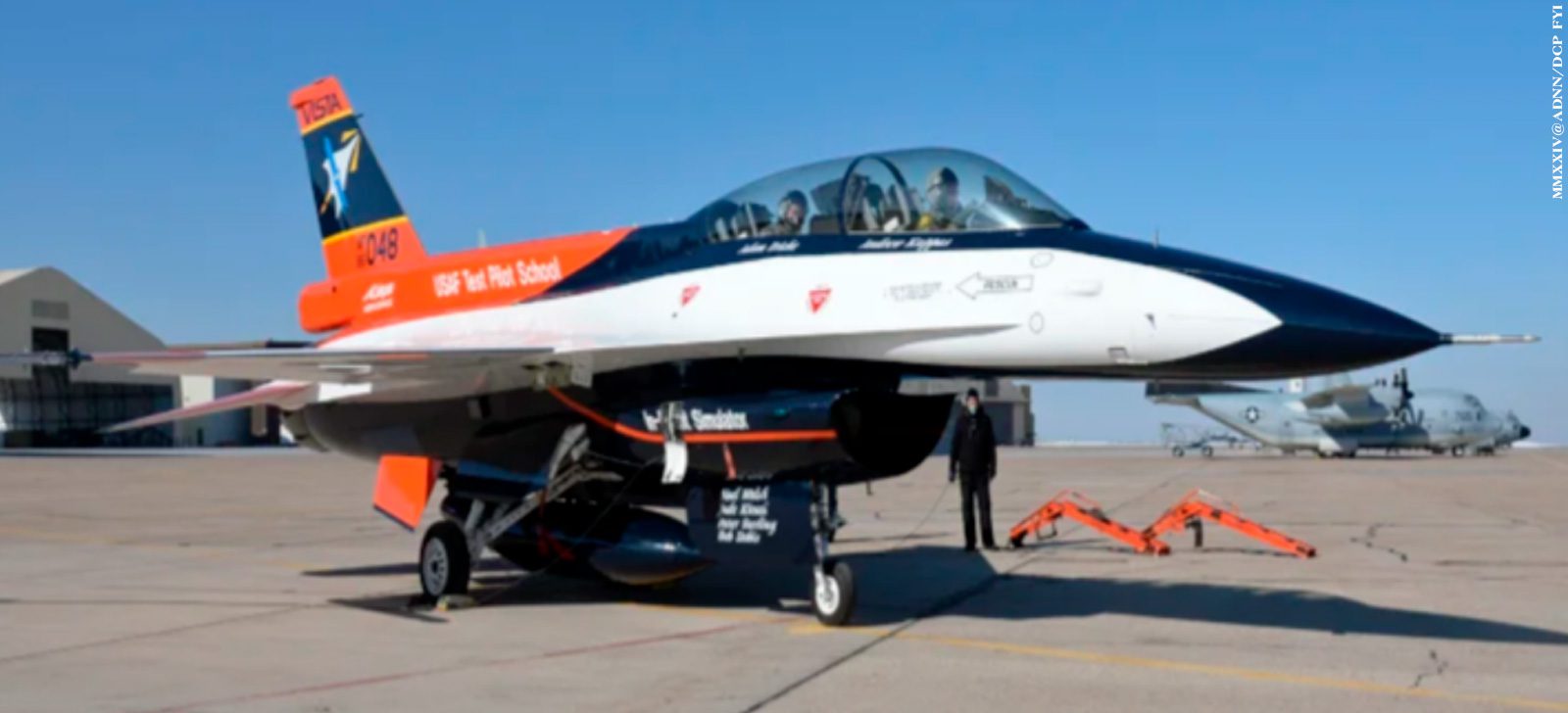The first air combat with AI and human pilots is an event promoted by the US Air Force (USAF) that is redefining the paradigms of aerospace history. From the conception of the NF-16D to the development of the X-62A, each step of this journey represents an innovative process in the use of artificial intelligence in military aviation.
The development of the X-62A
The X-62A has a history dating back to the NF-16D, designed by Mike Marchat in 2019. Initially designated the NF-16D, on June 14, 2021, the fighter was renamed the X-62A after modifications made by General Dynamics and Calspan, adapting it for use by the United States Air Force (USAF). This experimental model, derived from the F-16D, features a multi-axis thrust vectoring (MATV) engine nozzle, allowing active post-stall control, increasing maneuverability and maintaining control of pitch and yaw movements at different angles of attack.
The NF-16D is essentially an F-16D Block 30 based on the Israeli Air Force’s structural design, notable for the development of Direct Voice Input and the “Virtual HUD” in its design. The aircraft is currently employed by the USAF Test Pilot School, based at Edwards Air Force Base and maintained by Calspan. It plays a key role in test pilot missions, academic projects and flight research, with future plans to incorporate Autonomous Control of Simulation (SACS) to operate it as a Skyborg.
On April 18, the USAF promoted the aircraft’s participation in a historic milestone: the first air combat with AI, highlighting the continuous progress in the development and integration of advanced artificial intelligence technologies in military aviation.
Air combat between AI and human pilots

In September last year, the US Air Force announced that a computer-controlled F-16 fighter had engaged an aircraft in aerial combat at Edwards Air Force Base in California. The two aircraft engaged in close visual range combat, reaching speeds of up to 1,200 miles per hour. In one impressive moment, the fighters came within just 2,000 feet (610 meters) of each other.
After this experience, the X-62A variant emerged, also known as VISTA, which consists of a modified version of an F-16 equipped with an AI program. Built in December 2022, the model has already carried out around 21 test flights, totaling more than 17 hours in the sky.
This event marked the first time an AI-controlled aircraft has been used in combat. The USAF revealed that, during the flight, the artificial intelligence algorithm carried out data analysis and made decisions in real time, in a process called “machine learning”, reflecting the way fighter pilots hone their instincts over years of practice. In addition, DARPA released a video of the combat, offering a glimpse of the aircraft in action in the skies.
Despite the presence of human pilots on the X-62A to deactivate the AI system if necessary, this action was not required at any time. In a statement, DARPA stressed that AI-controlled air combat against humans represents a transformative moment in aerospace history.
We have to trust these algorithms to use them in a real-world environment,” said Lieutenant Colonel Ryan Hefron, program manager at DARPA.
Although the US military has used autonomous aircraft for decades, the use of machine learning has been banned for years due to the high risk and lack of independent control. So, in order to enable the combat that took place last Thursday (18), DARPA dedicated its efforts to developing an AI system capable of flying autonomously like a jet fighter, while maintaining the strict safety protocols of the Air Forces.

US Air Force to reveal more details soon
During the 21 flight tests of the X-62A at Edwards Air Force Base, human interventions were required almost daily to carry out reprogramming, resulting in changes to more than 100,000 lines of code.
In response, the US Air Forces emphasized that human involvement will continue to be crucial to operating autonomous weapons systems, even in future scenarios. However, the intention is that the level of human intervention during decision-making will be gradually modified over time.
Skyborg
The Skyborg Vanguard Project is an innovative initiative in the field of military aviation, which aims to develop and implement autonomous unmanned aircraft systems, known as “combat drones”, for integrated operations with the United States Air Force. This project represents a significant leap forward in the use of artificial intelligence and automation in military aviation, with the aim of improving combat capabilities, reducing risks for human pilots and exploring new strategies for air operations.
The name “Skyborg” is a combination of “sky” and “cyborg”, reflecting the idea of a collaboration between machines and humans in the sky. The development of the Skyborg Vanguard Project involves the creation of a systems architecture that enables communication and cooperation between manned and unmanned aircraft. AI is designed to provide real-time support, such as tactical decision-making, target selection and adaptation to unforeseen situations. These autonomous systems must be able to operate in complex and dynamic environments, carrying out combat and reconnaissance missions.
The Skyborg Vanguard Project brings with it a number of potential benefits for military aviation and national security:
- Risk Reduction: With AI piloting combat drones, human pilots’ exposure to risky situations is significantly reduced, increasing their safety.
- Operational Efficiency: Autonomous systems can perform repetitive and complex tasks faster and more efficiently than humans, improving mission effectiveness.
- Rapid Adaptation: AI can learn and adapt to new scenarios and tactics more quickly than humans, making it a valuable tool in constantly evolving combat environments.
- Strategic Collaboration: The ability to work together with manned aircraft opens up opportunities for more flexible and coordinated strategies, maximizing tactical potential1.
Despite the presence of human pilots on the X-62A to deactivate the AI system if necessary, this action was not required at any time. In a statement, DARPA emphasized that the combat.
*** Translated by DEFCONPress FYI Team ***
